
History of the Cold Weapon of Ukraine
by
ANTON V.VLADZYMYRSKYY
(Special English Presentation)
Before Timeģ The Stone Age
The most ancient weapon, found on territory of Ukraine, was created by the people of Ashelskaya culture (more than 100 thousands years B.C.). It was: triangular or oval-form stone axes ("rubilo"), wooden spears without heads but with burned tip ("oskep"), "bear's spears".
Later, Musterskaya and Srubnaya culture used "rubilo", "spears", axes, bows, darts, slinger, "rogatina" ("bear's spear"), knives.

Pic.1.Silicon weapon of The stone age (spears' heads, "rubilo"-axes, arrowhed, knives)
KNIVES OF THE STONE AGE
100-30 thousands years befor Christ on territory of Ukraine the people of musterskaya culture begin to use "T"-form stone knifes of the following types:
Types under form:
In period 12-6 thousands years before Christ are widely applied microlits (small rectangular, subrectangular and triangular silicon plate). Strengthening with help of resinous substances microlits in split of wooden handles, the ancient people created various instruments, including knifes. Are known thin short double-edged silicon plate, being edges of knifes, serving for thin operations, and powerful long (about 15,0 cm), slightly curved silicon knifes, used, obviously, in hunting.
Silicon knifes of Tripolie's culture are original: silicon blades - extended, double-edged, symmetric or wide and arc-form; handles - were produced from bones of the animals and, probably, killed enemies; such anatomical formation as joint's heads and etc. used like pommels.
The Ancient Time. The Bronze Age
Culture:
Cimmeric, Pozdne-Yamnaya, Srednedneprovskaya, Stanivskaya, Katakombnaya, Srubnaya, Chernolesskaya etc.Weapon: swords, celt-axes, bows, spears, knives, daggers.
The sword was standart weapon. All ukranian swords has:
SWORDS FROM GALICHINA made from bronze. The blade is straight. The first one third of blade is narrow, then extension, the second and third one third are wide, and a little narrow pot near the tip. The ricasso is ōCö- form. The pommel is round with little tang button.
SWORDS OF BONDARKHINSKAYA CULTURE The blade is straight, long, double-edged. The pommel is rectangular. There is a short straight crossguard.
SWORDS OF SABATINOVSKAYA AND BELOZERSKAYA CULTURES The blade is short, straight, double-edged.
KNIVES OF THE BRONZE AGE
Occurrence of metals has resulted in present revolution in manufacturing of knifes. Occur wide leaf-form double-edged blades, with well expressed edges of rigidity; are available handle's basis, supplied or small expansion to end, or short quillon, or rhombus a thickening on middle. Begins to be developed a new kind of the weapon - the dagger.
Katakombnaya culture. People of this culture are used:
Yamnaya culture. In described period have occurred bronze double-edged spear-form knives and bronze knives with triangular blades. Are still used ancient silicon knifes.
Bondarkhinskaya culture. The foremen of the given culture produced knifes, blades which had the rather specific form: from handle there is the first direct site, equal about to the half of general length, has a kind of a rectangular; the second direct site, having a kind of a triangle, lays in that planes, as first, but is displaced in party. In section knifes rectangular. As are known bronze straight double-edged blades, iron knives in arrowhead-form.
Gaalshtat. Knives of two kinds are known:

Pic.2. Knife made from bronze
Rising of the metal. The Early Iron Age
The first brightest development of the iron's weapon on territory of Ukraine is connected to development and statement cimmeric's people and their influence to another cultures. For example, daggers of Chernolesskaya culture have wide leaf-form or oval double-edged blades, flat or with central-fixed edges of rigidity, the handle is straight with small oval extensions, back edge is arc-form. Chernolesskaya's knives made form bronze or iron.
Cimmeric daggers represent by self reduced copies of swords, though samples with rather thin blade and without crossguard, supplied mushroom-form are known. Also used knives with double-edged straight blade and crown-form pommels. More often it is total dagger's handles were produced from bronze, and blades - from iron (it so-called bimetallic dagger). Are known daggers with richly decorated geometrical figures by handles. The knives, obviously, become by the more and more tool but the weapon. They, as a rule, one-edge and straight. Early cimmeric knives were produced from bronze, and late - from iron.
 Pic.3. Bronze and cooper weapon of the Bronze Age (axes, "celt"-axe, arrow- and spearheads, knives, short sword)
Pic.3. Bronze and cooper weapon of the Bronze Age (axes, "celt"-axe, arrow- and spearheads, knives, short sword)
CIMMERICSÆ SWORDS
The blade is straight, double-edged, with triangular tip. The ricasso is:
The pommel is:
Some handles have rectriangular clipping in the middle part. Swords made from iron or from bronze; or handle made from bronze, blade made from iron (so-called bimetallic swords).The lenght is about 100,0 cm.
Four basic types of Cimmerics' swords
1. Karasukskiy type - swords made from bronze. The handle is very short.
SWORDS OF CIMMERICSÆ TIMES - SWORDS OF CHERNOLESSKAYA CULTURE Swords of Chernolesskaya culture - it is analogous by Cimmerics' swords. The blade is straight, double-edged, made from iron. The handle is short, made from bronze. The lenght is 180,0 cm, the lenght of the blade is 95,0 cm.

Pic.4. Handles of the cimmericÆs swords
Legendary fearless rider-warrior - skyfs (or as they named self - skolots) dominated on grounds of South Ukraine on border of our and old ages. This people, which Gerodot has named " horsemen pointers from bow", has generated unique and advanced for time a type of arms, allowing skyfs to induce horror on numerous peoples of Asia and East Europe of Europe.

Pic.5. Skyf-warrior
AKYNAK is traditional skyf's sword. It is short sword (with the lenght 30,0 - 50,0 cm) with straight, double-edged blade, the tip is triangular. The ricasso is heart-form or butterfly-form. The upper part of sheath is heart-form or butterfly-form too. The pommel is rectriangular-form. Sometimes blades of akynaks were made from iron, and the handle was made from bronze or gold and bones. The handle and the sheath is ornamented by gold and animals' images (this is so-called Animal Style): griphons, lions, deers, fishes etc. Some akynaks ornameneted by Assirian figures: monsters with bow and mens or lions or griphons heads.

Pic.6. Akynaks with sheats decorated by the Animal Style
Examples. Akynak from Pobuzie. The sword made from iron. The pommel is antenna-form. The lenght is 42,5 cm, the lenght of the blade is 29,0 cm, the width of the blade is 3,0 cm. Akinak from Alexandrovka (Dnepropetrovsk province) This is a weapon of V centures B.C. The blade is straight, double-edged. The handle is straight, for one hand. The pommel is round. The ricasso is butterfly-form. The handle made from gold. The sheath made from iron, ending by round part.
It is accepted to allocate four types of knives, which used by skyfs (in basis of this classification a way of manufacturing is fixed basically, but is discounted and design):
Skyf's knife had as a rule straight blade, triangular in section, sometimes arc-form back-edge is presented. In common blades was produced from iron, handles - from bone or wood. Common length of a knife about 11,0 cm.
Speaking about skyfs, it is necessary to mention "animal" style - use of figures of the anima
ls in registration of subjects ß¹“Ó, weapon and etc. Griphons, the deers, panters, fish and etc. invariable decorated sheaths, handles, pommels. We shall recollect a gold figure panter from iron round board, or gold deer from Kostroma Groove, gold board of sword from Kelermesskogo Groove with fantastic essences in figures of which many essences armed bows were whimsically mixed bulls, lions, sheeps, griphons.
Pic.7. SkyfÆs arrowheads
In I-II centuries skyfs was destroed by the sarmat's people from Tanais. Sarmat's swords is long, powerful, used for choping. The blade is triangular. The lenght is 40,0-50,0 cm and more. Many sarmats' swords are ornamented by gold, flowers, life's scenes.
The IV-II cc. B.C. There are sickle-form and long pommels. The ricasso is little, rectriangular, straight or curved down. The blade is short, straight, double-edged, delicate, with central rib. The handle is flat. Swords made from bronze. The lenght of the blade is 38,0-40,0 cm. The width of the blade is 4,2 cm.
The VI-V cc. B.C. The pommel is antenna-form. The ricasso is straight and short. The upper part of the blade is rectriangular, the lower part - is triangular.
The I-II cc. A.D. The pommel is circles-form. The ricasso is straight, short and flat.
The blade is:
The handle is:
The sheath made from wood and bronze. It is red. There is an extension in upper part of the sheath for the ricasso. The lenght of the blade is 33,0-46,0 cm (50,0-60,0 cm), the width of the blade is 3,0-5,0 cm (6,0-6,5) cm, the thickness of the blade is 0,7-1,0 cm, the lenght of the ricasso is 5,0-7,0 cm, the thickness of the ricasso is 0,2-1,0 cm, the diameter of the pommel is 5,0cm (3,0 or 4,0-4,5cm).
In latest time. The handle is pivot-form. Sometimes it is the round pommel made from bones, gold, jewels. There are wood and bronze plate on the handle.The blade is triangular. The ricasso is rectrian-gular.Some swords don't have ricasso (the blade is double-edged and triangular, lenght of blade is 90,0 cm, wide of blade is 8,0 cm). The sheath is made from wood and iron.It is red. Lenght of blade is 100,0 cm (50,0-
70,0 cm), wide of blade is 3,5 cm,wide of ricasso is 1,0 cm, lenght of handle is 10,0-15,0 cm.

Pic.8. SarmatÆs sword
The Way Of Settlers. Weapon of GreeceÆs and RomeÆs settlers
Between ages many settler's city was founded in Crimea and South Ukraine by greeks and romanians - towns of Khersoness, Olvia, Pantikapey on the coast of the Black Sea.
SWORDS OF ROME
GLADIUS The blade is straight, short, double-edged, wide. The lenght is 60,0 cm, the lenght of the blade is 30,0-40,0 cm, the lenght of the handle is 15,0 cm.
SPADA. The blade is straight, short, double-edged. The lenght is 75,0-80,0 cm, the width is 4,0-5,0 cm.
 Pic.9. Greek's settlers' weapon (arrows- and spearsheads, swords)
Pic.9. Greek's settlers' weapon (arrows- and spearsheads, swords)
SWORDS OF GREECE
Made from iron. The blade is straight, short, double-edged. The handle is cylindrical. The pommel and the ricasso are rectangular. Made from iron. The blade is long, straight, single-edged, extension. The ricasso and the pommel are ōCö-form.
Nomad Power. Weapon of NOMAD AGE (EARLY MIDDLE EDGE)
AVARS' SWORDS
SWORD (PALLOS) Made from iron. The blade is very long, straight, single-edged. Made from iron. The blade is short, double-edged, straight, narrow. The lenght is 40,0 cm.
TIME OF THE GREAT BULGARIA
PALLOS (SABRE) The blade is straight. It is ornamented by gold and jewels. For example, pallos with gold handle was finded near Poltava.
GERMANIAN (GOTS)
SEAX Sword with short, single- or double-edged, first curve, then straight blade. The pommel is round. The lenght is 40,0-75,0 cm, the width of the blade is 3,5-4,0 cm, the lenght of the handle is 17,0cm,weight is 0,66-0,72kg.
SPATA Sword with long, straight, double-edged, wide, heavy blade.
SWORDS OF IV-V CENTURES Swords with short double-edged blade, which extension on first and second one third and narrowing near the tip. The lenght of the blade is 45,0 cm.
GHUNNS
SWORD (PALLOS) The blade is straight and double-edged. The handle's part of blade is wide. The sheaths is ornamented by long narrow plate with the round cuttings.
SALTOVO-MAYATSKAYA CULTURE (THE UKRANIAN PEOPLE OF KHAZAR'S KAGANAT)
SABRE The blade is little curvatured, near the tip the blade is double-edged. The handle is straight or curvatured. The pommel is oval. The handel's part of blade is rectriangular,with 2 apertures for fixing parts of handle(so-called ōshechkiö). For handels: the lenght is 8,0-13,0 (11,0-13,0) cm, the width is 2,6-3,4 cm,the thickness is 0,8-1,6 cm.
POLOVTSI AND PECHENEGI
SABRE The blade is long, little curvatured. The handle's part of blade is rectriangular and there are two apertures for fixing handle's parts (so-called ōshechkiö). The crossguard is narrow and rectriangular or wide and rhombic.
 SWORD The blade is long and single-edged, with very little curvature near the tip. The handle is short and straight. The crossguard is straight. The lenght of blade is 80,0 cm.
SWORD The blade is long and single-edged, with very little curvature near the tip. The handle is short and straight. The crossguard is straight. The lenght of blade is 80,0 cm.
Pic.10. Nomad's sabres
NEW World. Age of Kievskaya Russ
Kievskaya Russ - first state of the slavs, arising in 9 centuries.
Weapon: slinger, spears ("oskep", spear, "sulitsa"), shields, gladius, saxs, knives, swords, sabres, "konchar", kords, axes, little axes, "kysten", bear's spears, bows, quivers-"saadak".
Armour: helmets, body armours ("baydana", "colontar", "ushman", "bakhterts", "zertsalo", "batirlik"), shields (drop, "paveza"), "chaldar" - armour for horse.
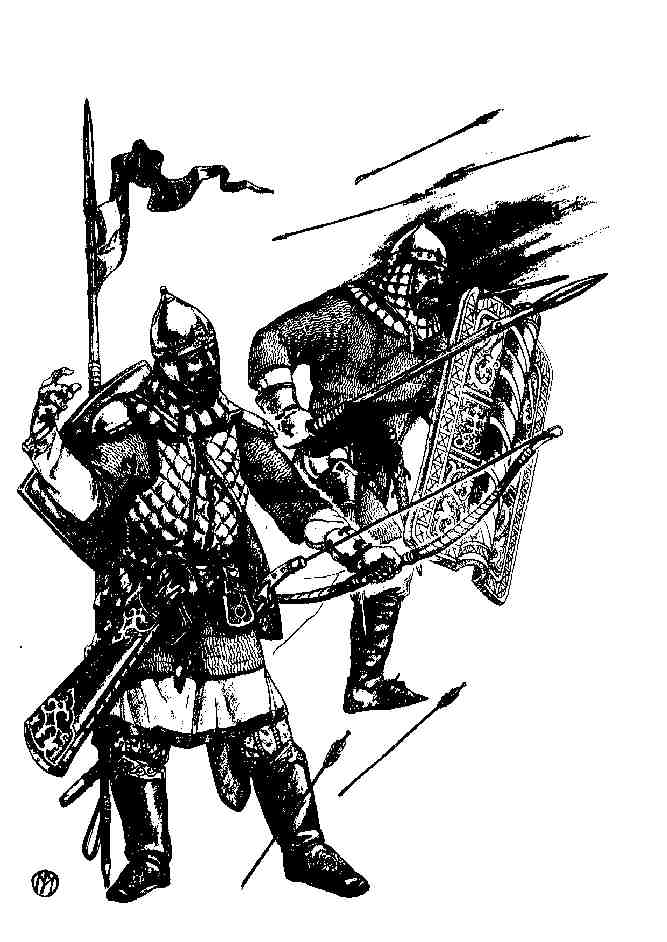
Pic.11. Slavs' warriors
SWORDS OF EARLY SLAVS' CULTURES
SEAX - Sword with short, single- or double-edged, first curve, then straight blade. The pommel is round. The lenght is 40,0-75,0 cm, the width of the blade is 3,5-4,0 cm, the lenght of the handle 17,0 cm, the weight is 0,66-0,72 kg. Weapon of the Chernyakhevskaya culture.
GLADIUS - The blade is straight, short, double- or single-edged, wide. The ricasso and the tip is rectangular.The lenght is 60,0 cm, lenght of the blade is 30,0-40,0 cm, the lenght of the handle is 15,0 cm. Weapon of the Pshevorskaya culture.
Slavs used scandinavian's type of the sword, so-called "mech". There are double-edged and heavy blade, rectriangular ricasso-crossguard, very big pommel, which consist from rectriangular and semilunar parts. The lenght is 100,0 cm, the lenght of the blade is 80,0 cm, the width of the blade is 6,0 cm, the lenght of the ricasso-crossguard is 10,0 cm.
Swords of:
Early times the weight is 1,5 kg, the lenght is 95,0 cm.
Before Mongolian Intrusion the weight is 2,0 kg, the lenght is 120,0 cm.
XI-XII centures the weight is 1,0 kg, the lenght is 86,0 cm, the lenght of the handle is 9,0-10,0 cm, the lenght of the ricasso-crossguard is 9,0-12,0cm.
XII-XIII centures all pommels made from iron(not from bronze). The lenght of the handle is 12,0 cm, the lenght of the ricasso-crossguard is 18,0-20,0 cm. All blades are wide and double-edged.
SWORD'S CLASSIFICATION BY PETERSON
The IX - XI centures
Type B
The ricasso-crossguard is no wide. The pommel is triangular. There is a projection on the ricasso-crossguard and on the pommel. The blade is narrow. Time of using is the VIII-IX c.
Type D
The pommel is large and round. The handle is ornamented by bronze. There are brands (trade marks) on the blade: circles, crosses. Time of using is the IX c.
Type H
The pommel is triangular. The crossguard is straight and no wide. There are brands (trade marks) on the blade: circles, crosses, Ulfberht, Leutlrit, L. Time of using is the second half of the X-XI cc.
Type S
The pommel consists of three or five parts. The middle part is large. The crossguard is with extension of ending. The handle, pommel and crossguard is ornamented by animals eyes and loops. There are brands (trade marks) on the blade: Ulfberht, C. Time of using is the X-XI cc.
Type T-1
The pommel consists of three parts. The middle part is large. The other parts are ornamented like animals faces. The pommel and the crossguard is big. The handle is ornamented by ribbon. There are brands (trade marks) on the blade: Nred and fpit, Ulfberht, crossrs. Time of using is the second half of the X c.
Type T-2
The pommel consists of three parts. The crossguard is straight. The handle is ornamented by the rhomb, gold, silver, copper. There are brands (trade marks) on the blade: Cerolt, Ulfberht. Time of using is the X c.
Type E
The pommel consists of three parts. The pommel is semilunar. The crossguard is straight. There are brands (trade marks) on the blade: crosses, mens, Ulfberht, C, ribbons. The lenght of sword is 126,0 cm. Time of using is the IX-X cc.
Type V
The pommel consists of three parts. The pommel is semilunar. The crossguard is straight. The handle is ornamented by geometric and vegetation figures. There are brands (trade marks) on the blade: Ulfberht, circles, Ingelrii (me) fecit (ōIngelrii makes meö).
Type U aspecial
The pommel is semilunar. The crossguard is straight and rectriangular. Time of using is the X c.
Type W
The pommel is semilunar. The crossguard is straight and narrow. The handle made from bronze.Time of using is the first half of the X c.
Type X
The pommel is semilunar. The crossguard is straight, no wide, long. There are no ornamentes on the handle. There are brands (trade marks) on the blade: Ulfberht, Ulen. Time of using is the second half of the X - beginig of the XI cc.
Type Y
The pommel is saddle-form with elevated in the middle. The crossguard is straight or curved down.There are no ornamentes on the handle. There are brands (trade marks) on the blade: Inglriifeci. Time of using is the X-XI cc.
Type Z
The pommel consists of three parts, curved up,with elevated in the middle. The crossguard is curved down. There are brands (trade marks) on the blade: crosses, C. Time of using is the XI c.
Type Z aspecial
The pommel has a lens-form.The crossguard is curved down.The handle is ornamented by vegetation figures. There are brands (trade marks) on the blade: some letters, crosses. Time of using is the XI c.
Type A inhabitant
The pommel consists of three parts. The pommel and the crossguard are curved. The handle is ornamented by vegetation figures (ōThe Tree of Worldö). Time of using is the X-XI cc.
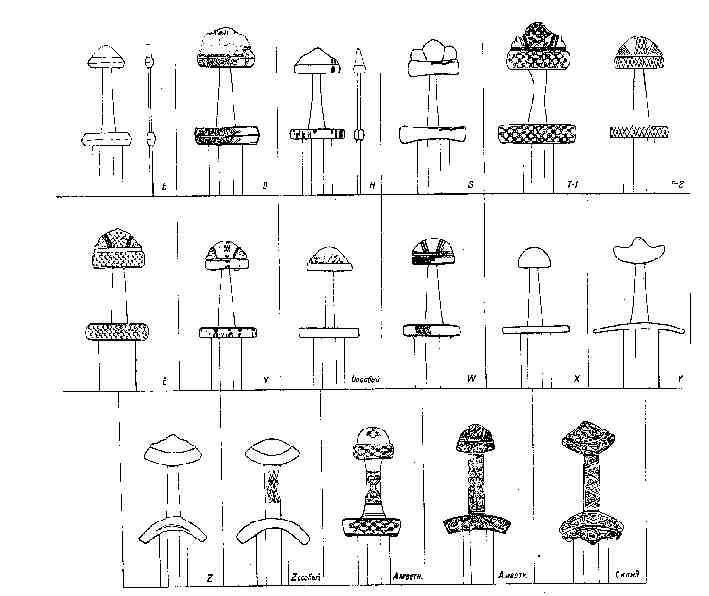 Pic 12. Swords of IX-XI cc.
Pic 12. Swords of IX-XI cc.
The second half of the XI - XIII centures
Type I
The crossguard is straight or little curved, made from bronze. The pommel consists of five parts, made from bronze too. This type developmented from Type S. The handle is ornamented by circles and crosslines. There are brands (trade marks) on the blade: INICINI. There are three translatings of this word:
1. I[esus] N[azarenus] I[esus] C[hristus] I[esus] N[azarenus] I[esus] (by A.I. Zaytsev).
2. I[n] N[omine] I[esu] C[hristi] I[n] N[omine] I[esu] (by A. Geyshtor)
3. I[n] N[omine] I[esu] C[hristi] I[n] N[ostros] I[nimicos] (by I. Shimanskiy).
Time of using is the XII-XIII cc.
Type II
The pommel consists of three parts, made from bronze or iron. The crossguard is little curved. There are brands (trade marks) on the blade: Ctclin me fecit, [I]n nomine domini.
Type IIa
The pommel made from bronze. The pommel and the crossguard ornamented by man's face with moustaches. The handle is ornamented by vegetation figures.
Type III
The pommel is saddle-form. The crossguard is curved down. The handle is ornamented by vegetation figures. Time of using is the XII and the first half XIII cc.
Type IV
The pommel is semilunar. The crossguard is straight and long. The blade is large and heavy. There are brands (trade marks) on the blade: NNMIICITIMNI, Iinomi dominin. Time of using is the XIII c.
Type V
The pommel has a lens-form. The crossguard is straight, long, pivot-form. The blade is large and heavy. There are brands (trade marks) on the blade: crosses, circles, shields, Ingelrii. Time of using is the XII-XIII cc.
Type VI
The pommel has a form of a disk. The crossguard is straight long pivot-form (round or square). The blade is large and heavy. There are brands (trade marks) on the blade: crosses, circles, latins inscription:
1. By 23-24 letters with words: ACPUNE and NED. They are translated by A.I. Zaytsev: A[rma] C[epi] P[ro] V[ictoria] N[ominis] E[terni] D[omini] E[terni] R[egis] U[niversi] E[terni] O[mnipotentis] ... E[terni] D[omini] A[rma] C[epi] P[ro] V[ictoria] N[ominis] E[terni] S[ancti] - ōI take weapon for victory of forever God, forever king of Universal, forever God. I take weapon for victory of name of Godö
2. SOS OSO It is translated by A. Geyshtor: S[alus] O[mnium] S[alus] O[mnium] S[alus] O[mnium] - ōSaving of all savingö and ōOf all saving of allö
Time of using is the XII-XIII cc.
Type VII
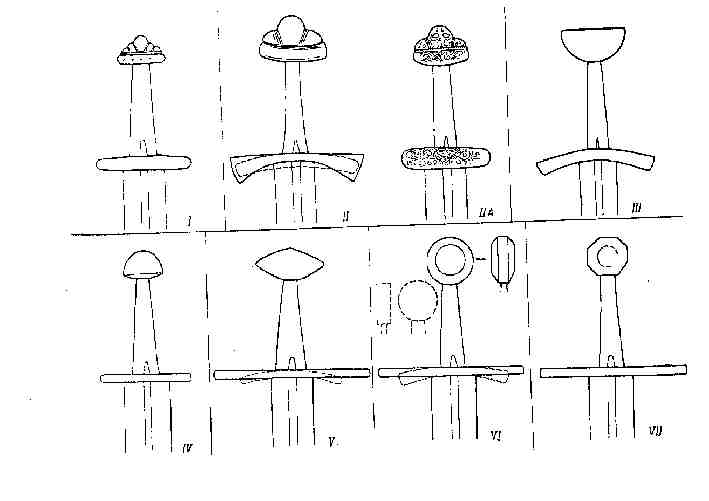 The pommel with 5-8 edges. The crossguard is straight or little curved. The lenght is 120,0-140,0 cm, thelenght of the handle is 20,0-30,0 cm (for two hands). here are brands (trade marks) on the blade: ōHonorem meum nemini daboö. Time of using is the XIV-XV cc.
The pommel with 5-8 edges. The crossguard is straight or little curved. The lenght is 120,0-140,0 cm, thelenght of the handle is 20,0-30,0 cm (for two hands). here are brands (trade marks) on the blade: ōHonorem meum nemini daboö. Time of using is the XIV-XV cc.
Pic.13 Swords of second half of XI-XIII cc.
SWORD FROM FOSHEVATAYA (Poltava's province). So-called
FOSHEVATOVSKIY SWORD
Sword of scandinavian type (XI c.). The handle made from bronze. It is ornamented by imaging of monsters (like on Runes Rock). There is a brand (trade mark) on the blade: ōK
ŅŌÓļ³ ╦■õŅ“Ó (╦■õŅ°Ó )ö (ōKoval Ludota (Ludosha)ö), translated like ōBlacksmith Ludota (Ludosha)ö.This is most ancient weapon with cyrillic brand. This is the brand of the first ukrainian swordmaking blacksmith.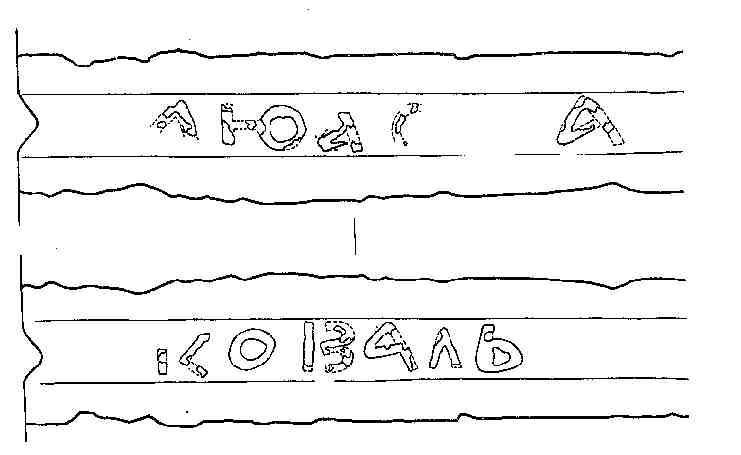
Pic.14. The first ukrainian sword's brand
KHARALUZNIE SWORDS
About this weapon was talked in the ōWord About Igor's Armyö (XII c.) Some scientist translete ōKharaluznieö like ōEast's Steelö from Damask. But some words, like ōkaratabanö and ōkarakhorosanö (the name of east swords XIII c.) contain ōkaraö. We think that word ōKharaluzieö developmented from ōKarlukö (or ōKharlukö or ōKharluzö) - named of tribe in North Afganistan(X-XI c.). People of this tribe was great sword's makers.
SABRE - The blade is little curvatured. The crossguard is straight. The lenght is 120,0 cm.
KONCHAR - The blade has a form of a cone, with 3-4 edges.
RAPIR - Easy sword with a long and a slim blade.
KORD or KORDELAYS - The blade is short and straight.
KNIVES OF KIEVSKAYA RUSS
The knife was the most popular weapon and tool in Kievskaya Russ - first ukrainian state. Only in Novgorod was founded out 8000 knives. The first written mention of knifes can be found out in "A Word about Igor's regiment", relating by 12 century; are here described After-boot knives.
Two versions of knifes were basically used:
1. Blade with curved to the tip by an edge and straight back-edge;
2. Blade with curved edge and back edge.
Handles of both variants were produced of wood or bones, very seldom - from metal. All blades in section had wedge-form. Length of blades changed within the limits of 4,0-20,0 cm.Sheats were made from developped leather, device - from silver, cooper, iron.
Five technological receptions were applied:
- welding blade from three strips;
- welding steel edge ti the iron strip;
- combined welding with manufacturing figured back-edge;
- cementing of iron for blade;
- manufacturing general steel.
Among knives of Kievskaya Russ it is possible to allocate four main groups:
1. AFTER-BOOT - most ancient of known types; had triangular bent balde; was had for upper part of the boot.
2. BELT KNIFE - most popular kind; had double-edged blade; blade's length is 15,0 cm, width is 20,0-25,0 cm.
3. INTRASHEATS - was applied to punching of armour; had wide blade, little curved near the tip; common length is 50,0 cm, length of the blade is 40,0 cm; was had in special jack in sheats.
4. FIELD KNIFE- mainly hunter's type of a knife; had unilateral edging and edge, smoothly passing in the tip; the handle is flat; common length is 20,0-25,0 cm.
It is necessary to notice, that besides "common" knives, described above, existed and
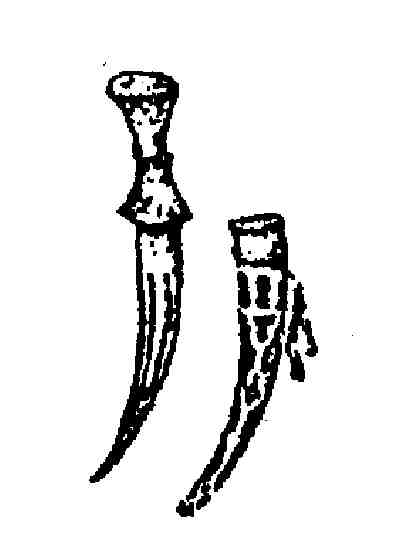 special knives-tools.
special knives-tools.
Pic. 15. After-boot knife
Four typs of KNIVES of Kievskaya Russ:
|
"Zasapojnie" (After-boot) |
is very ancient weapon. The blade is curved and triangular. |
|
"Poyasnoy" (belt knife) |
is very popular weapon. The blade is straight and double-edged. Lenght of blade is 15,0 cm, width 20,0-25,0 cm. |
|
"Podsaadachniy" (Intrasheats) |
the blade is width, with curved near the tip. The lenght is 50,0 cm, the lenght of blade is 40,0 cm. |
|
"Polevoy" (Field knife) |
weapon for hunting. The blade is single-edged. The handle is flat. The pommel is mushroom-form. The lenght is 20,0-25,0 cm. |
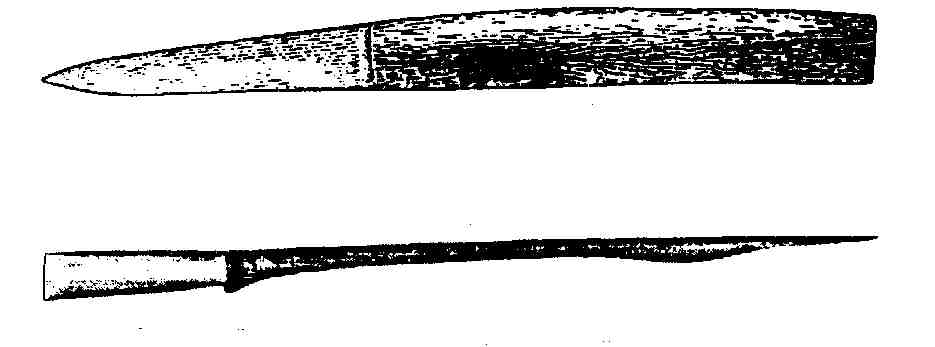
Pic.16. Slavs' knives

Pic. 17. Simple clubs ("bulava" ) and flying clubs ("kysten")

Pic.18. Helmet of the knyaz
In XI c. mongolian invaders from Gold Hord, was occuping territory of Kievskaya Russ and controling it during three centures.
SWORD - Weapon of richmen and notable.The handle is straight.The pommel is horizontal or vertical circle.
SABRE - Weapon of all soldiers. The blade is very curvatured, wide, with large extension near the tip.The crossguard is curvatured and with a quillon. The ricasso has a cross-form. The sabres is ornamented.
The Warriors Of The Frontier. Age of kazaks
15-18 centuries the border of Ukraine was protected by kazaks from Zaporojskaya Sech. It was national ukrainian warriors-rebels, who was fight again polish, turcian and russian imperior invaiders.
Weapon: club ("bulava", "pernach" or "shestoper", "komyshina", "lyska"), sabres uf kazaks, Turcian, Polish, Russsian types, spears ("spis", "pyka"), daggers ("kama", "bebut"), knives, shashkas, "volchek", bows, "kelep".
SABRE (so-called SHABLYA) - is the real kazak's weapon. Kazaks used many types of sabres (from Krimea, Turkey, Poland, Russia).We know kazak's sabre with words from Koran or with the Russian's State Emblems on the blade. Sabre for kazak is noble weapon. It is used against honest and noble warriors, but against tatars kazaks used ōno sabre, but stickö. So, kazaks used polish, hungrian, turkey, persian, Caucases's, russian types of sabre, and, of course, own kazak's type of sabre.
RUSSIAN SABRES
The XVII c. The blade is wide and curved, there is short extension near the tip (so-called elman). The crossguard is rhombic.Ornamented by gold and silver.The lenght is 90,0 cm. The sheath made from wood, skin, iron.
TheXVIII-XIX cc. The handle with knuckleguard and two arcs. The lenght of the blade is 88,0 cm, the weight (with the sheath) is 2,0 kg. The sheath made from iron.
TURCIAN SABRES
The blade is curvatured, single-edged, with short extension near the tip. The handle is short. The pommel is flat. The crossguard is straight and rhombic.
HUNGRIAN SABRES
This sabres is analogous with Turcian sabres. There is chain between the pommel and the crossguard (like knuckleguard). The crossguard is ōSö-form.
PERSIAN SABRES
The blade is narrow, little curved. The crossguard is rhombic, very long, straight. The upper part of the handle is curved by 90 degree (this is the pommel).
POLISH SABRES (or CARABALLA)
The blade is very wide, little curved. The upper part of the handle is curved by 90 degree (this is the pommel). The crossguard is rhombic,the quillon is short and curved down.
KAZAK'S SABRES
Sabre with very curved, delicate, light, single-edged blade. The handle is ō
├ö-form. The crossguard is straight. The lenght is about 130,0 cm.Yavornitskiy about kazak's sabres: ōZaporozskie kazaks used sabre not very curved and not very long... but of high quality and very sharp... The handle often ornamented by skin of sea's fishs and they are ending with the head of any bird or animal; the blade often has a gold stripe... The sheath or ōpikhviö is from wood, ornamented by skin and iron.ö

Pic.19. Kazaks' sabres
In the XIX centure kazaks used:
"VOLCHEK"
It is a variety of the sabre. The blade is little curved. It is weapon for chop and prick. The first volcheks prodused in Zolingen and Pussau (Germany), they had a trade mark - The Wolf. Then these sabres started producing in Ukraine and in the Caucases.
SHASHKA
The blade is long, little curved. There is no crossguard or ricasso. The upper part of the handle is curved (this is the pommel). Some shashkas of Russia have crossguards.
In 1838 - the lenght is 103,0 cm (officers 96,0 cm), the lenght of the blade is 87,5 cm (82,0 cm), the width of the blade is 3,6 cm (3,5 cm), the weight is 1,5 kg (1,4 kg).
In 1839 - the lenght of the blade is 60,0 cm.
In 1881 - the lenght is 102,0 cm, the lenght of the blade is 87,0 cm, the width of the blade is 3,3 cm, the weight is 1,5 kg.
In1904 - the lenght is 92,0 cm, the lenght of the blade is 71,0 cm, the width of the blade is 3,5 cm, the weight is 1,0 kg.

Pic.20. KazakÆs clubs
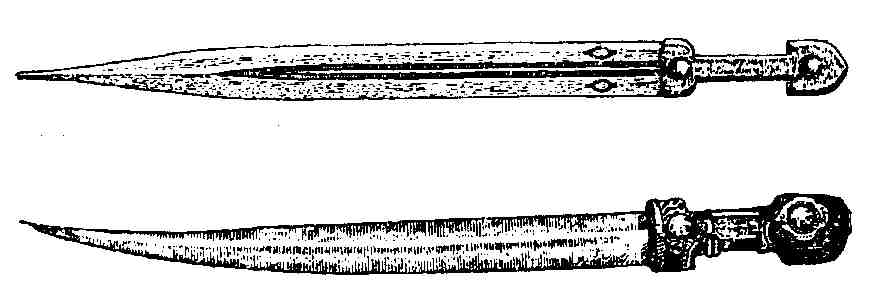
Pic.21. Kazak's daggers (from Caucassian origin) - "kama" and "bebut"
KNIVES TODAY
In second half 20 centuries on territory of USSR - Ukraine there was the unique and interesting tradition of manufacture of knives in prisons. The manufacture of knives by the private persons was forbidden. The state factories let out some versions hunters and restaurants of knifes. The militarians knifes were inaccessible for collectors. Therefore collecting and use prison (so-called "zekovskiy noj" - prisoner's knife ) knifes has become very popular among whole population (not by criminals), though the large part from these knifes - unlegal and is forbidden to use.
 Pic.22. Military knives (Soviet times)
Pic.22. Military knives (Soviet times)
The tradition of "zekovskie" knives has really arisen in Gulags and prisons, when on shift roughly made "zatochka" and "shtir" (stab weapon - think sharp grinded metal stick) or so-called "shilo" (stab weapon - stretch spoke) have come "sadilnik" or "sajalo" - knives, secretly made in prison's plants. In due course the separate foremen reached all greater perfection, with permission of prison's administrations (rather their manufactures actively using products) they got by own specialized workshops, raw material and even by the students, organizing line manufacture.
Classification of prisoner's knives:
Prisoner's knives are rather diverse under form and sizes. Many of them looks like antique swords or cutlasses of 18-19 centuries, or some on modern survival knives. The majority of Prisoner's knives of rather poor quality, it is caused by that, first, many foremen give more than attention to appearance, so to say to design, knive to the detriment of its battle characteristics, and secondly, poor technology and materials.
There are a few types of Prisoner's knives.
"Begunok" - folding knife with spring mechanism.
"Bes" - folding knife with triangular blade.
"Vikidukha" - folding knife.
"Jabokol" - fixed knife.
"Kosulya" - hunter's knife. The handle made from deer's leg (the pommel is formed by the hoof).
"Kyshkoder" - knife with cog on back-edge.
"Pero" or "Pyka" - knife with straight thin strab blade.
"Plet'" - balisong.
"Phinka" - pseudonational knife (first type - looks like traditional Suomi puuko, second type - knife with thick, straight double- or one-edged blade and crossguard).
"Shuchka" - folding "S"-form knife.
In 1999 the first book about Prisoner's knives was published in Ukraine (and in ex-USSR) - A.V.Vladzymyrskyy "Zekovskie Noji".
|
|
|
|
Prisoner's knives for hunters |
Prisoner's folding knives |
|
|
|
|
Prisoner's knives for hunters - "Kosulya" (The handle made from deer's leg (the pommel is formed by the hoof)) |
amator made traditional knife of west Ukraine |
Pic.23. Prisoner's knives
THANK YOU!
Mail to:
E-mail:
avv@dsmu.donetsk.ua WEB-site: http://www.dsmu.donetsk.ua/~avvAddress: Vladzymyrskyy A.V. Ulitsa Levitskogo, dom 21, kv.1
83048 Donetsk Ukraine
FidoNet: 2:465/196.2
Tel. (0038-0622) 553-623
® Anton Vladzymyrskyy, 2000